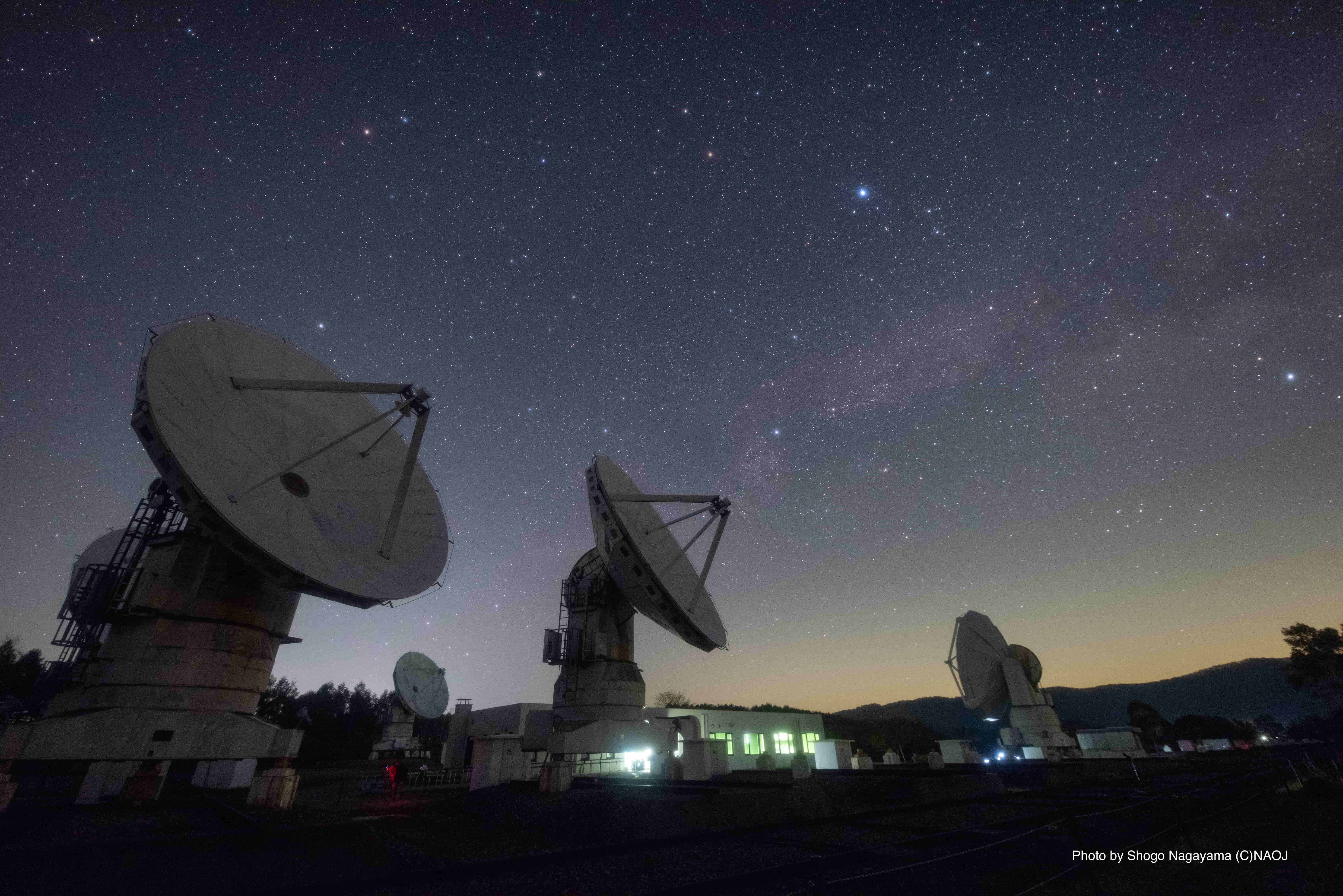Protection of radio astronomy
What is Radio Astronomy ?
You can see many stars shining in the sky when you look up at night. Some of you may have seen falling stars in the starry sky over remote locations. It makes you realize that there are countless stars shining in the Universe.
The Sun is the closest star. The surface temperatures of normal stars range from thousands to tens of thousands of degrees. It is difficult to imagine from their faint glow that the stars twinkling in the night sky are such hot, violent objects. That is because they are so much farther away than the Sun.
Astronomy is the study of the Universe. Do you think we can understand everything about the Universe just by observing the visible light detectable with the naked eye?
That is not the case. Radio astronomy is a method to explore other aspects of the Universe that are completely invisible in visible light.
The Universe Seen by Radio Waves
What can we observe through radio waves ?In the space between stars, there is a substance called the "interstellar medium," which is the material for making stars. The interstellar medium is composed of gas consisting of hydrogen as the main component and solid fine particles called "dust" with diameters of 1 micrometer (1/1000 mm) or less. Though it is nearly impossible to learn the details of the interstellar medium through visible light observations, it is possible through radio observations.
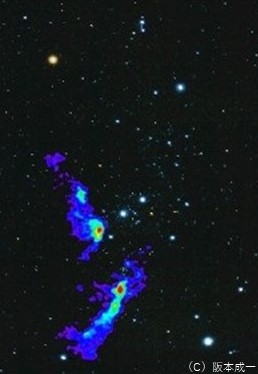
© Seiichi Sakamoto
This image is the carbon monoxide molecular spectral intensity distribution (in 230 GHz) around Orion taken by the University of Tokyo’s 60-cm radio telescope. The color indicates the strength of the radio waves, red → yellow → light blue → blue → purple in order of decreasing strength.
In addition, we can learn more about the Sun, the most familiar celestial body, through radio wave observations of phenomena such as violent explosions on the surface and the release of material. This is important not only for understanding the Sun itself, but also for understanding phenomena closer to home, such as the environmental changes in the upper atmosphere of the Earth and the effects on communication operations.
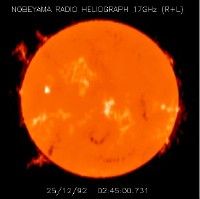
This image shows the Sun in 17 GHz taken by the Nobeyama Radioheliograph.
Radio Wave Utilization
What makes radio astronomers unique among “radio wave users” ?
① Passive Only
Commercial or amateur radio wave use typically involves transmission and reception of radio waves. In contrast, radio astronomy observation only passively receives radio waves from natural phenomena and does not transmit.
② Observed Signals Contain Various Frequency Components and Have Independent Information in Each Frequency
In industry, so long as the transmitter and receiver radio wave frequencies are the same, the same exchange of signals and information can be conducted even if shifted to a different frequency.
But in radio astronomy the targets are natural phenomena so we can’t shift their radio signals for our convenience. In addition, astronomy signals include multiple frequency components, and each component carries different information.
For example, the frequencies of radio waves emitted by various molecules contained in interstellar gas have discrete values dictated by quantum mechanics (line spectrum), and each molecular species has a unique “fingerprint.”
The only way to learn the nature of a celestial body is to receive a large number of frequency components "as they are."
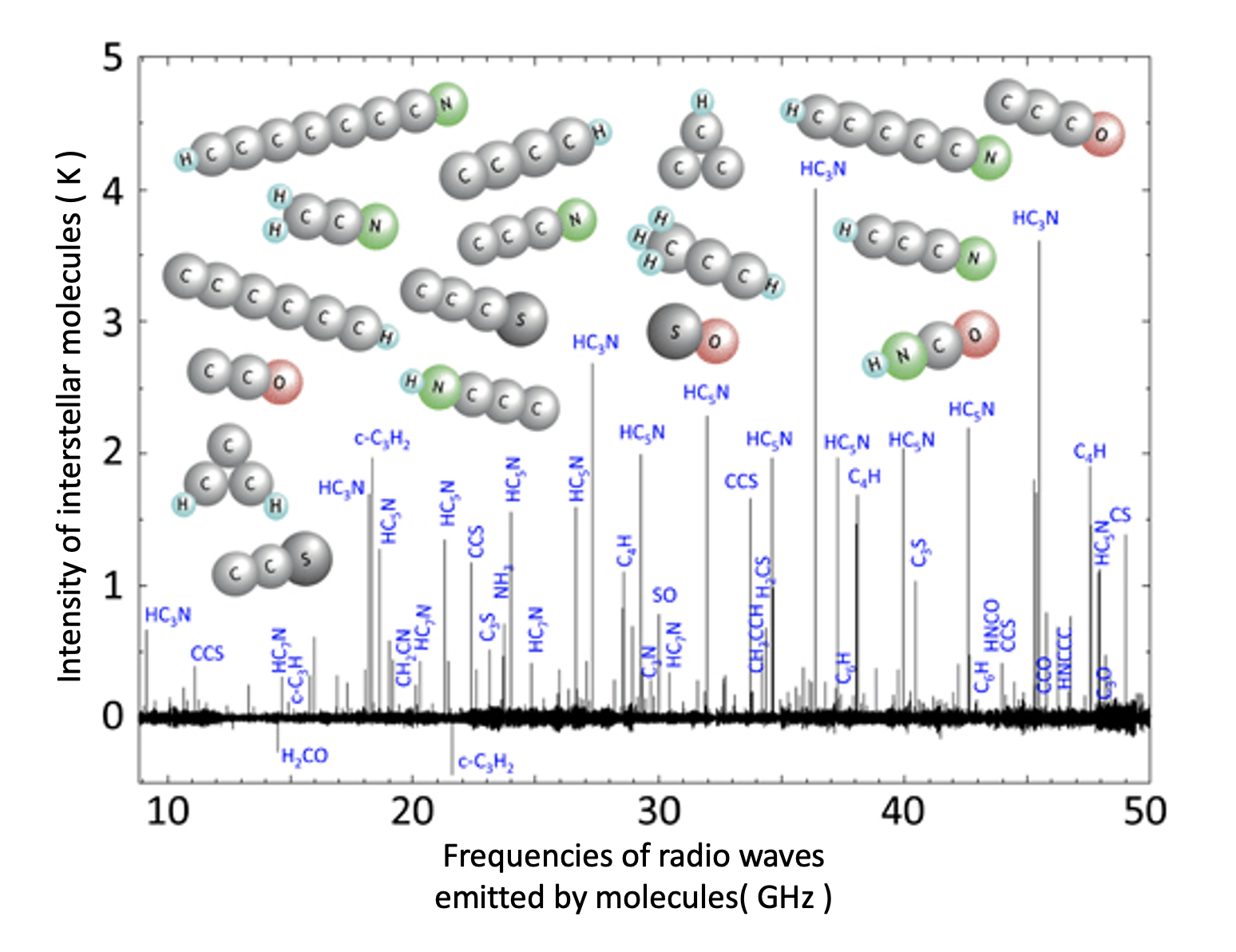
Interstellar molecule spectrum (in 8.8-50 GHz) of a cold gas cloud by the Nobeyama 45-m Radio Telescope.
A total of 414 spectral lines from 38 different types of interstellar molecules have been detected.
Modified from Kaifu, N., et al. 2004, PASJ, 56, 69 (Figure 1)
③ Receiving Weak Radio Waves
Radio waves from celestial bodies are extremely weak. Therefore, they will be disturbed and disappear if mixed with artificial radio waves from other radio users.
The devices used in radio astronomy, called radio telescopes, have ultra-sensitive receiving systems optimized for extremely weak signals. There is even the possibility that strong artificial radio waves could destroy the receiver completely if they enter the device directly.
Coexistence of Radio Astronomy and Other Endeavors
Based on these characteristics of radio astronomy, the following measures are generally taken in order to ensure healthy growth and peaceful coexistence with other users.
① Allocation of Frequency Bands for Radio Astronomy
Frequency bands particularly important for radio astronomy are designated to give priority to radio astronomy services in those bands.
Even within these frequency bands, if equal priority is given to other services,
astronomers in Japan can submit an application to the Ministry of Internal Affairs and Communications for special restrictions which apply only in the area around the radio telescope.
Once the application is accepted, it is obligatory to refrain from emitting artificial radio waves within the area.
② Operational Agreements and Geographical, Temporal, and Frequency Separation
The frequency bands allocated to radio astronomy by themselves are not sufficient for the advancement of radio astronomy research.
Observations in other frequency bands require coordination with other users.We will negotiate and request that they refrain from radiating artificial radio waves as much as possible,
in the places and times that the radio telescopes are in operation, or to use another frequency, or another method which does not involve wireless communication.
The parties will seek the best solution for their individual cases and may conclude an operational agreement when they agree.
The Spectrum Management Office, representing the interests of radio astronomy researchers, is engaged in various activities for coexistence under smooth negotiation with other users.
⟩⟩Process of Frequency Assignment in Japan
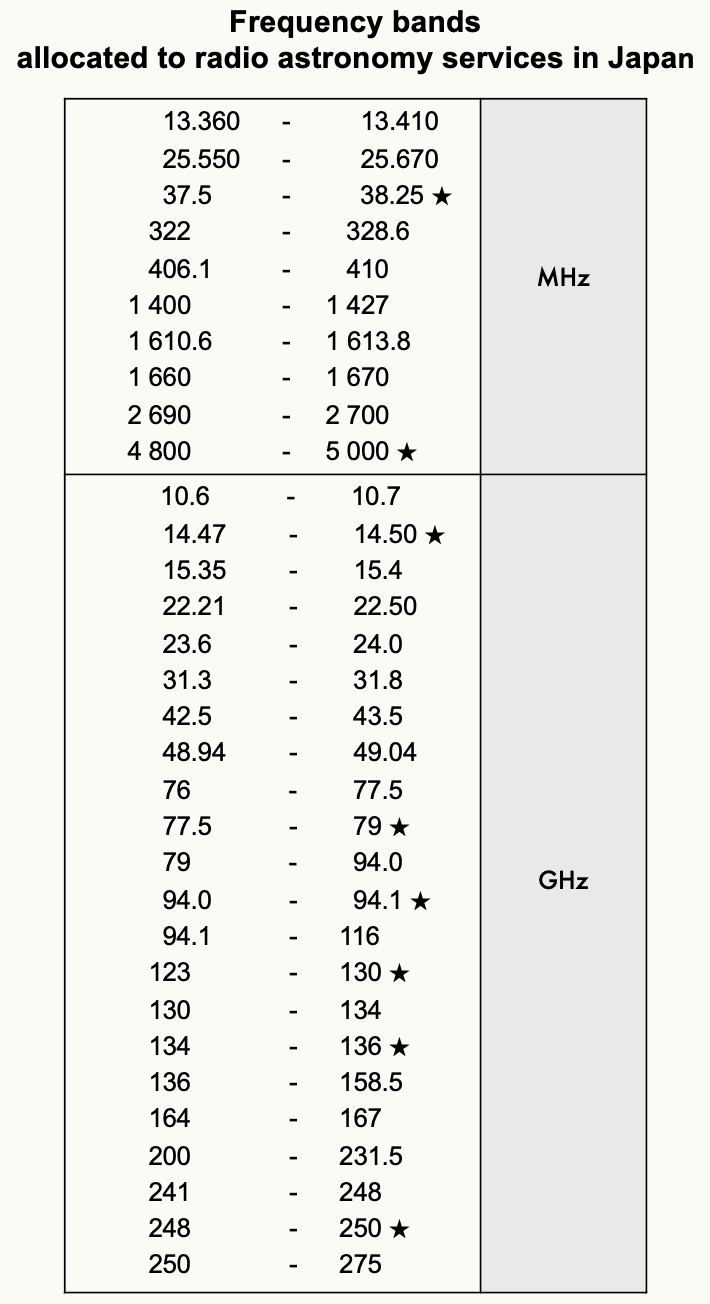
Sharing of Radio Frequencies
Activities to Protect Radio Frequencies
We conduct the following activities to protect the observation environment for radio astronomy.
Radio Frequency Sharing and Compatibility Studies
Radio astronomy observations are “passive” in that they "receive" extremely weak radio waves emitted by celestial bodies. Most other services using radio waves are “active” services that "emit" radio waves. Radio astronomy telescopes have extremely high sensitivity radio-receivers, so they are affected by radio waves emitted from active services (RFI: radio frequency interference).
Active and passive services often use the same frequency bands due to radio frequency resource limitations. In order to avoid radio frequency interference, we have to carefully consider whether multiple businesses can use radio waves in the same frequency band.
Consideration of sharing and compatibility for radio frequencies involves examining the level of radio frequency interference to other services expected, and also solutions to avoid or reduce the interference.
The Spectrum Management Office works to protect the environment for domestic radio astronomy observation through individual negotiations or discussions with active services at the meetings hosted by the Ministry of Internal Affairs and Communications.
Individual Projects are explained in more detail below.
International Regulations
The improvement of international telecommunications and the rational use of frequency resources require the cooperation of each country. The International Telecommunication Union (ITU), one of the specialized agencies of the United Nations, is responsible for maintaining cooperation among the 193 member states.
Spectrum Management Office staff attends the ITU meetings to consider international agreements on the use of radio waves and makes contributions to the protection of radio astronomy observations.
Proposals to Avoid Radio Frequency Interference
The Spectrum Management Office makes proposals to various media and submits opinions for public comments by the Ministry of Internal Affairs and Communications on applicable issues, to avoid radio frequency interference to radio astronomy observations, from the perspective of astronomy researchers.
Latest Studies on Radio Frequency Sharing and Compatibility
(Last updated in November 2025)
16
Sharing Study on Upgrading FWA Systems (Continued)
(Continued)15
Sharing Study on Upgrading STL/TTL/TSL Broadcasting Systems(Continued)14
Compatibility Study on Radio Communication Systems using HAPS(Continued)13
Compatibility Study on Railroad Communication Systems in the 40 GHz Band(Continued)12
Sharing and Compatibility Studies on Non-Geostationary Satellite Systems(Continued)11
Sharing Study on Automotive Radar Systems(Continued)10
Sharing Study on Airborne Communication systems(Finalized March 2025)09
Sharing Study on Wireless LAN Systems (Wi-Fi) in the 6 GHz Band(Continued)08
Sharing Study on Introduction of Digital Transmission Systems to Shortwave Fixed Stations(Continued)07
Sharing Study on 5G Mobile Phone Systems in 5th Generation Mobile Communication (5G)(Continued)06
Sharing Study on Airport FOD (Foreign Object Debris) Radar in 90 GHz Band(Finalized January 2024)05
Sharing Study on Widening the Bandwidth of Wireless LANs(Continued)04
Compatibility Study on WPT (Wireless Power Transfer) Systems(Finalized May 2021)03
Compatibility Study on Wireless Systems in 60 GHz Band Radio Equipment(Finalized December 2020)02
Sharing Study on UWB Wireless Systems used Outdoors in an Expanded Frequency Band(Finalized October 2020)01
Impact of PLC (Power Line Communication) on Astronomy Shortwave Observations(Finalized October 2020)
16
Sharing Study on Upgrading FWA SystemsIn August 2025, a sharing study was started to migrate FWA systems currently operating in the 26 GHz band to the 22 GHz band,
in preparation for new use of 5G mobile phones in the 26/40 GHz bands.
Radio astronomy stations in Japan conduct observations in the 22 GHz band, and the 22 GHz band includes primary allocated bands to radio astronomy for primary service,
22.21 - 22.5 GHz and 23.6 - 24.0 GHz,
and the footnote J39 requires “all practicable measures to be taken to protect radio astronomy operations from harmful interference” in 22.01 - 22.21 GHz, 22.81 - 22.86 GHz and 23.07 - 23.12 GHz.
The sharing studies with radio astronomy indicated that a separation distance of 140 km is required between a FWA system and a radio astronomy station in the same frequency band,
and 84 km is required in the adjacent bands,when facing directly each other.
Another sharing studies considering terrain for each radio astronomy station concluded that a protection zone is required around the target station.
Therefore, before deploying a FWA system, operational coordination with radio astronomy is required.
(Continued)
15
Sharing Study on Upgrading STL/TTL/TSL Broadcasting SystemsIn January 2025, in response to the growing demand, a sharing study was started to change the system for efficient use of frequencies for broadcasting systems. Since the frequency bands under consideration include the radio astronomy bands, we will closely monitor the details of the study to avoid harmful interference to radio astronomy.
(Continued)
14
Compatibility Study on Radio Communication System using HAPSIn October 2024, a compatibility study for the practical application of HAPS (High Altitude Platform Station) was started. HAPS is a system that builds a network by aircrafts in the stratosphere, at an altitude of about 20 km above the Earth. The system is expected to be institutionalized in stages according to the status of aircraft development. Communication between HAPS stations and mobile stations uses the 2 GHz band, and that between HAPS stations and ground gateway stations uses the 40 GHz band, both of which bands are close to those allocated to radio astronomy. We continue the sharing study to determine separation distances between stations for HAPS and radio astronomy stations.
(Continued)
13
Compatibility Study on Railroad Communication Systems in the 40 GHz BandIn December 2024, a compatibility study to institutionalize a railroad communication system which uses 40 GHz was started.
There have been growing demands for transmitting images from surveillance cameras installed on platforms to the driver's cab of a one-man train for safety confirmation when boarding, exiting, or departing.
The system is also assumed to be used for communications between trains and control centers.
The target frequency bands are 43.52-45.46 GHz, and the adjacent band,42.5-43.5 GHz, allocated for radio astronomy.
As a result of the sharing study, a separation distance of several tens of kilometers is required between a railroad communication system and a radio astronomy station when they are facing each other.
If a railroad communication system is installed within this limit, the direction of the antenna must be adjusted not to face a radio astronomy station.
In April 2025, MIC called for public comments regarding the results of the study. The Radio Astronomy Frequency Committee of NAOJ submitted an opinion confirming that individual coordination should be made in advance if a 40 GHz railroad communication system is to be installed within the separation distance from a radio astronomy station.
【Ministry of Internal Affairs and Communications Public Comments (Japanese Language)】
(Continued)
12
Sharing and Compatibility Studies on Non-Geostationary Satellite SystemsA number of projects are planned to provide communication services around the world by a large number of satellites working together. There are concerns about the impact of reflected light from the satellites on optical and infrared astronomy, as well as the impact of radio waves used by satellites for communication and that leak from the satellites themselves, on radio astronomy.
【English translation of NAOJ Statement on the Potential Impairment of Astronomical Observations by Satellite Mega-Constellations, March 13, 2020; original Japanese statement, July 9, 2019】
Four study meetings were held in 2019 and six in 2020 to consider how to avoid the effects from the communication satellites. The compatibility study with radio astronomy involves examination of whether the emissions from the satellites meet the epfd (equivalent power flux density) threshold value of -241 dBW/m2/100-MHz, under the condition that radio waves are not emitted in the direction of radio astronomy antennas in 10.7-10.95 GHz, which is adjacent to the radio astronomy band of 10.6-10.7 GHz. The result of the Monte Carlo simulation shows that both the Koganei station* and the Ishioka station* satisfy the requirement of less than 2 % data loss.
The draft report from the study meeting was reported to the Subcommittee on Information & Communication Technology * after public comments.【Ministry of Internal Affairs and Communications Public Comments (Japanese Language)】
We started a sharing study on Space Cellular proposed by Rakuten Mobile in April 2021. Space Cellular is a system that connects to mobile phones on the ground via satellites so that mobile phones can be used even in mountainous areas. The radio waves between the satellites and ground stations are planned to be used in bands used by radio astronomy observation or an adjacent band. In July, the result of the frequency sharing studies for Space Cellular in the Q / V band for the feeder link was presented, which demonstrates the need for a clear definition of sharing conditions such as the direction of the satellite's main beam and unnecessary radiation limits.
In March 2024, compatibility studies were started on the technical requirements for two mobile satellite communication systems using non-geostationary satellites. One is a communication system in the altitude of 600 km by Amazon Kuiper using a part of Ka band (18-30 GHz), and the other is a direct communication system with cell phones by Starlink using the 2 GHz band. Neither of these bands overlap or adjacent to the radio astronomy bands, but we continue to participate in the discussion to protect radio astronomy.
In April 2025, MIC called for public comments regarding a draft version of ministerial ordinance to partially revise the Radio Law Enforcement Regulations, as institutional arrangements for the introduction of Inmarsat IoT-type services. The frequency band used by Inmarsat mobile earth stations for uplink (1626.5 - 1660.5 MHz) includes the important band allocated for radio astronomy services on a primary basis (1660 - 1670 MHz), and also includes the bands where all feasible measures must be taken to protect radio astronomy services from harmful interference. The Radio Astronomy Frequency Committee of NAOJ has expressed the opinion that sufficient measures should be taken to prevent harmful interference to radio astronomy stations.
【Ministry of Internal Affairs and Communications Public Comments (Japanese Language)】
(Continued)
11
Sharing Study on Automotive Radar SystemsThe millimeter wave bands are important for radio astronomy. Automotive radar for collision prevention has been developed because of the need to reduce traffic accidents caused by automobiles.
For coexistence of radio astronomy and automotive radar, the following measures should be taken.
(1) Minimize the output power of automotive radar,
(2)Automatically suppress the output power when approaching the protected area, which is set around the radio astronomy observatory that observes those frequencies.
(3)Set up signs on the road near the radio astronomy observatory to alert people to the protected area.
Actual measurement data of 76GHz radar measured at Nobeyama Radio Observatory



For the existing automotive radars in the frequency band 76 - 77 GHz, the maximum transmitted power from the antenna and the maximum gain of the antenna are limited. This regulation was old, established 25 years ago, so the automobile radar industry requested new regulations based on the internationally used equivalent isotopic radiation power (e.i.r.p.), which is obtained by the product of transmitted power and gain.
We started a sharing study for the new radar systems and the existing wireless systems in January 2022. Since the frequency band 76 - 77 GHz is important for radio astronomy, we presented the protection criteria for radio astronomy and the details of domestic radio astronomy facilities operating in the same frequency band (Nobeyama Radio Observatory and 4 VERA stations: Mizusawa VLBI Observatory, VERA Ogasawara station, VERA Ishigakijima station, and VERA Iriki station) to prevent interference.
In 2024, we are discussing sharing conditions in collaboration with automotive radar developers.
(Continued)
10
Sharing Study on Airborne Communication systemsCurrent mobile phones are expected to be used at a height of 1.5 m above the ground, but there have been requests for permission to install mobile phones in drones to use them for communications, so we participated in the study meetings held by Ministry of Internal Affairs and Communications to examine the issue. Except for use in the 1.5 GHz band, which would affect radio astronomy observations, it is now permitted to use them at a height of 150 m or less.
At the meeting in 2019, the bands that could be used by airborne mobile phones were limited to the 800 MHz / 900 MHz / 1.7 GHz / 2 GHz bands, intentionally excluding bands which could interfere with radio astronomy observations.
(Partially finalized in December 2019)
There have been requests to use airborne mobile phones over 150 m, use ones with TDD systems, and use ones in the frequencies including 5 G. Ministry of Internal Affairs and Communications restarted the sharing studies in August 2022.
As a result of the sharing studies,
it is permitted to use them over 150 m on the conditions that
1. exclude the use in the 1.5 GHz bands,which could interfere with radio astronomy observations.
2. limit the transmission power.
When we consider compatibility with the radio astronomy and mobile phones, it is necessary to maintain a minimum separation distance from the radio astronomy stations in using mobile phones.
(Finalized in October 2022)
In 2024, a sharing study on airborne communication systems, including drones, which use 5.2 GHz wireless LAN was started.
The sharing studies are underway with existing satellite communication systems and 5.3 GHz meteorological radar.
In addition, in July 2024, another sharing study on airborne systems for TDD cellular (4G/5G), local 5G and BWA (Broadband Wireless Access) was started.
This is due to the growing demand for high-capacity communications by drones and the need for airborne systems used inside factories,
in the forestry and agriculture sectors, and for disaster prevention purposes.
The target frequency bands are 2.5, 3.4, 3.5, 3.7, 4.5, 4.7, 4.9, and 28 GHz.
Although the 4.9 - 5.0 GHz band is the secondary allocation for radio astronomy,
we are monitoring the situation in order to avoid harmful interference to radio astronomy.
In March 2025, Ministry of Internal Affairs and Communications(MIC) called for public comments on institutional development
for introduction of TDD cellular (4G/5G) airborne use.
(Finalized March 2025)
09
Sharing Study on Wireless LAN Systems (Wi-Fi) in 6 GHz Band(Partially finalized March 2022)
We started sharing studies between fixed systems for public services (services for the purpose of protecting human life and property, preserving public order,and carrying out any other kind of public services)
and for broadcasting services, and wireless LAN systems using the 6425- 7125 MHz in October 2022.
We could not reach an agreement on the consideration of sharing conditions, and we presented our opinion that radio astronomy service can be shared with wireless LANs only if harmful interference on the 6.7 GHz, in which CH3OH maser observations are conducted, can be prevented securely.
(Finalized in March 2023)
In October 2023, frequency sharing study in the 6425 - 7125 MHz band has been restarted. In the U.S., the Automated Frequency Control (AFC) function has been introduced for SP-mode wireless LAN systems with high output power, which automatically adjusts the output power of wireless LAN devices based on the location information of existing stations, to prevent interference. The possibility of applying a similar function to Japan has been discussed. We believe that this function will contribute to the protection of radio astronomy observations in the 6.7 GHz band and continue to participate in the discussion.
(Continued)
08
Sharing Study on Introduction of Digital Transmission System to Shortwave Fixed StationsWe started a sharing study on digitalyzing shortwave transmission in December 2022, since there have been requests to use them for services that require real-time processing, as shortwave transmissions have lower latency than satellite transmissions. The frequency bands requested to be used in digitalized transmissions are 3-30 MHz bands, which are allocated to fixed services. The radio astronomy bands (13.36-13.41 and 25.55-25.67 MHz) are to be excluded, but due to the high radiation power expected, it is necessary to consider the radiation leaking out of the band used for communications and to conduct a sharing study with radio astronomy.
The Ministry of Internal Affairs and Communications (MIC) proposed a maximum power of 10 kW and a required bandwidth of 12 kHz as the technical conditions for the sharing study. We continue the sharing study to avoid harmful interference, such as determining separation distances under the condition that radio astronomy bands are excluded.
(Continued)
07
Sharing Study on 5G (5th Generation Mobile Communication) Mobile Phone SystemsWe conducted a sharing study on the 5G mobile phone systems planned to be introduced in Japan. It is closely related to WRC-19 Agenda 1.13 and includes a study on operation in 41-43.5 GHz. The conclusion was that a separation distance of 35 to 45 km is required for coexistence with radio astronomy in the 42.5-43.5 GHz band.
Regarding the consideration of sharing between existing “public services” (services for the purpose of protecting human life and property, preserving public order,
and carrying out any other kind of public services) and new 5G mobile phone systems in the 2.3 GHz and 4.9 GHz bands, we started a sharing study in December 2020 with IMT (International Mobile Telecommunications) services based on the
dynamic frequency-sharing system with wideband sensing to seek for an available frequency band allocated for other wireless systems
in the 2.3 GHz band (a range of 100 MHz from 2300 to 2400 MHz).
We found that frequency sharing would be difficult because the minimum separation distance in the same frequency band needed to avoid interfering and being interfered with exceeds about 100 km.
In adjacent frequency bands, for interference from mobile phones’ radio waves, interference will hardly occur if a guard band of about 10 MHz is provided.
Even in the case that public services’ radio waves cause interference to the mobile phones, sharing is possible by using various technologies to reduce interference. Regarding technical conditions,
we will provide the conditions in 2330-2370 MHz next time.
Regarding the sharing with other primary service** systems in the 4.9 GHz band, sharing should be possible in some cases, by requiring a separation distance or a guard band of about 5 MHz.
In 2023, a sharing study in the 22/26/40 GHz bands was started with the aim of increasing frequency allocation to cell phones in the future.
In March 2024, the sharing study based on very simple assumptions showed that the distance between 5G stations using the 40 GHz band and radio astronomy observatories should be approximately 30 to 80 km or more to avoid harmful interference.
In 2024, more detailed sharing conditions were studied, and the results showed that sharing is possible if the separation distance between 5G stations using the 40 GHz band and radio astronomy observatories is approximately 40 km in the same frequency band,
approximately 35 km in the adjacent band, as long as the pointing direction of the 5G antenna avoids radio astronomy observatories.
Furthermore, considering the topography, it was concluded that sharing is possible under certain protected areas around radio observatories and appropriate operations,
as the number of designated radio astronomy observatories is limited, and they are far from densely populated areas where 5G stations mainly expected to be deployed.
In April 2025, the Ministry of Internal Affairs and Communications called for public comments on the technical conditions for the 5G mobile phone system (26 /40 GHz band).
【Ministry of Internal Affairs and Communications Public Comment(Japanese Language)】
(Continued)
06
Sharing Study on 90 GHz Airport FOD RadarSince October 2019, the Association of Radio Industries and Businesses (ARIB) has held study meetings on airport foreign object detection radars (officially designated “FOD,” Foreign Object Debris radar) scheduled to use the 92-100 GHz band. This frequency band is also assigned to radio astronomy, and we had a study meeting on compatibility in the frequency band where the radio astronomy receiving facilities are designated for protection. A report summarizing the results of the technical studies was submitted in March, 2020, finding that a sufficient interference margin can be secured for radio astronomy. Based on this report, this topic will be deliberated by the Information and Communications Council and the Radio Regulatory Commission of the Ministry of Internal Affairs and Communications.
(Finalized in October 2020)
In October 2023, a study group on FOD radar was established by the Ministry of Internal Affairs and Communications.
The sharing study has conducted in 81 - 109.5 GHz and it was presented that a separation distance of 112 km should be secured when an airport FOD radar and a radio astronomy station are facing each other, and if a separation distance of 112 km cannot be secured, measures should be taken such as installing an FOD radar in the opposite direction to the radio astronomy station, and installing a shield so that the radiated power toward the radio astronomy station should be reduced to -89.7 dBm or less. It was also suggested that a function be provided to stop the emission of radio waves when the radar is pointed in an unintended direction. We hope that the radar to operate in the way that prevents interference to radio astronomy stations.
(Finalized in January 2024)
In February 2024, the Ministry of Internal Affairs and Communications called for public comments, and the Spectrum Management Office has submitted an opinion in March, that, if the radar is to be installed at an airport located within 112 km of a radio astronomy station, the operator of the radar should individually coordinate measures to avoid harmful interference with the operator of the radio astronomy station.
【 Ministry of Internal Affairs and Communications Public Comments (Japanese Language) 】05
Sharing Study on Widening the Bandwidth of Wireless LANsThe standardization of IEEE802.11be (Wi-Fi7), which is expected in 2024, will realize the extension of wireless LANs to a maximum bandwidth of 320 MHz. In preparation for the standardization, sharing studies were started in April 2023 on widening the bandwidth and on the frequency extension to higher frequency bands than 6.425 GHz. We closely monitor the frequency extension progress to ensure that it does not affect astronomy observations, especially on CH3OH maser observations.
(Continued)
04
Compatibility Study on WPT (Wireless Power Transfer) SystemsWe have examined the required technical conditions compatible with the existing wireless systems when introducing wireless power transfer systems that transfer power by radio waves.
The target frequencies are the 920 MHz band, 2.4 GHz band, and 5.7 GHz band.
The study findings report that we should establish a restricted area where the WPT systems cannot be installed.
This draft report was submitted to the Information and Communications Council after approval by the Land Wireless Communication Committee,
and a partial report was submitted in July 2020. However, a note was added that we should consider creating a coordination mechanism for avoiding or mitigating harmful interference to the existing wireless systems.
In December 2020, a study group on WPT operation was established and started a study for coordination.
WPT is radio equipment installed only in closed, indoor spaces, and requires a license because it requires operational adjustment.
However, those with an output of 1 W or less in the 920 MHz band are designated as specified radio stations exempt from licensing requirements, so there’s no need to enlist radio operators.
It is desirable to establish an organization that takes the initiative in operating and adjustment instead.
In addition, the priority level under the Radio Law (primary service, secondary service or equivalent to RR4.4) is undecided and needs to be considered in the future.
At the meeting in February 2021, a draft of the protocol for WPT operation coordination was presented in preparation for a test run in the summer of 2021,
but the measures to prevent interference by WPT were inadequate.
Based on the feedback, a revised proposal was presented at the meeting in March 2021, ensuring the neutrality of the protocol and the protection of existing wireless systems.
In addition, a contact point for reporting harmful interference will be added after consideration in the Ministry of Internal Affairs and Communications.
The locations where WPT systems are expected to be deployed are factories, warehouses, big-box retailers, and nursing facilities. Among these, nursing facilities have wide openings, such as windows, so that sufficient wall attenuation cannot be obtained. Careful consideration is required for this point, and those who will install WPT should exercise caution in their operation.
The Ministry of Internal Affairs and Communications called for public comments, and one of them was that amateur radio communications might experience interference from WPT. To prevent interference, the WPT operators should make technical adjustments to avoid causing radio wave interference, and at the licensing stage, the Ministry of Internal Affairs and Communications will review whether the applications include adequate interference prevention measures.
WPT operation requires for licensees to disclose certain information to the public, and to keep in touch with those who could be adversely affected by WPT. Before full-scale operation of WPT begins, the result of this study should be announced to the public.
(Finalized in May 2021)
The Ministry of Internal Affairs and Communications called for public comments regarding the draft revision of the ministerial ordinance for introducing WPT systems in January 2022. The Spectrum Management Office has submitted an opinion requesting correction of the draft which does not sufficiently protect existing radio services including radio astronomy.
(February 2022)
【Ministry of Internal Affairs and Communications Public Comments(Japanese Language)】(June 2022)
03
Compatibility Study on 60 GHz Band Radio EquipmentSince radio astronomy observation in the 60 GHz band is infeasible due to atmospheric absorption, it would seem that there would be no adverse effects from radio facilities operating in the 60 GHz band. But an impact on radio astronomy observations in the 114-132 GHz band is expected from the second harmonic of 60 GHz waves. The result of the sharing study on the second harmonic shows that it is possible to coexist, provided that operators sufficiently suppress the unnecessary radiation and a sufficient separation distance is provided.
At the meeting in September 2020, it was reported that the separation distance needed to meet the threshold interference value of -30 dBm / MHz, which is the upper limit on the unnecessary radiation to avoid affecting radio astronomy observation, was 26 km in 76.5 GHz and 17.5 km in 115 GHz. On the other hand, the theoretical value of the unwanted radiation level generated by a pulse was lower than the limit value. It was -51 dBm / MHz in 76.5 GHz and -61 dBm / MHz in 115 GHz in the lossless case. The minimum separation distance in this case is about 500 m, and it was confirmed that if measures to prohibit the operation of the 60 GHz system only within the observatory sites are enforced, radio astronomy observations would not be affected. As a technical requirement, a function to stop radio wave emission is required.
The draft was reported to the Land Wireless Communication Committee in January 2021, and it was submitted to the Information and Communications Council after the call for public comments by the Ministry of Internal Affairs and Communications.
【Ministry of Internal Affairs and Communications Public Comments(Japanese Language)】(Finalized in December 2020)
02
Sharing Study on UWB (Ultra Wide Band) Wireless Systems Used Outdoors in An Expanded Frequency BandA study on technical conditions for expanding the frequencies of UWB (7.25 to 10.25 GHz band) wireless system used outdoors was held. The expanded frequencies are 6650-6675.2 MHz and 10.6-10.68 GHz, both of which were considered for sharing with radio astronomy. The result shows that sharing is possible, provided that regulations are implemented, such as restrictions on the areas where UWB can be used.
At the meeting in August 2020, the government, UWB business operators, and those who would experience interference had a meeting to consider the needed operational restrictions, and it was made possible for parties which may experience interference to request the suspension of operation near their sites. The devices with UWB systems must be equipped with a function to stop emission of radio waves to prevent interference. An operation manual is to be prepared describing how to stop the operation manually or automatically.
(Finalized in October 2020)
In August 2021, a revised ministerial ordinance regarding the expansion of the frequencies for the outdoor use of UWB wireless systems was announced,
and details of operational restrictions for outdoor use were posted on the Japanese version of “The Radio Use Website” of the Ministry of Internal Affairs and Communications.
【UWB wireless systems operational restrictions when used outdoors*(Japanese Language)】
On the website, a list of domestic facilities where UWB wireless systems may cause interference and the way to stop the emissions from the wireless devices equipped with UWB systems are posted,
calling attention to the requirement to refrain from using the devices near the radio astronomy facilities.
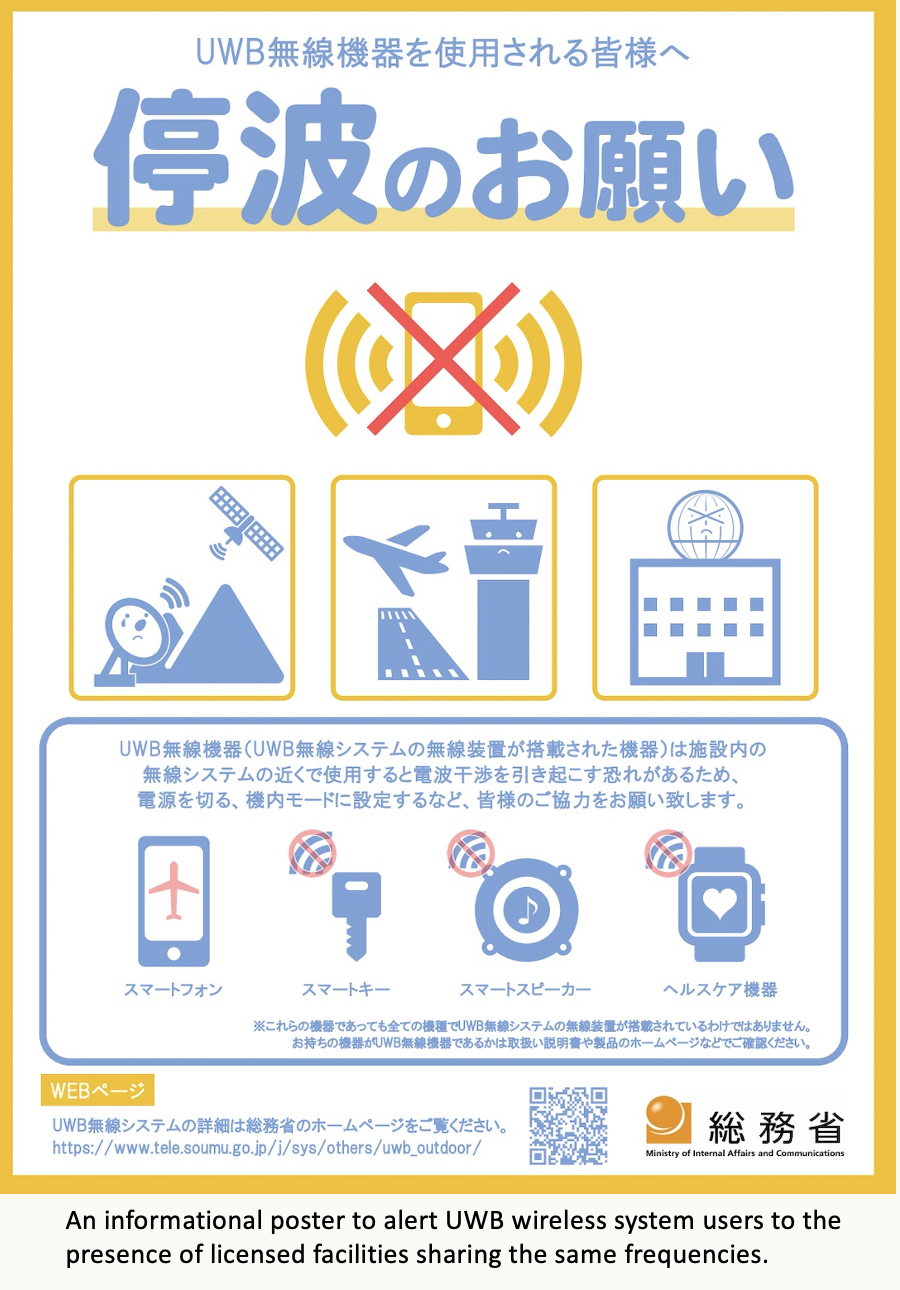
(September 2021)
The latest list of devices equipped with UWB wireless systems which can be used outdoors and are expected to cause radio interference to radio astronomy observation can be found here.
![]() ≫ List of the devices (October 2025)
≫ List of the devices (October 2025)
01
Impact of PLC (Power Line Communication) on Astronomy Shortwave ObservationsPower Line Communication systems (high-speed PLC) using shortwave bands has started operation,
but is not yet widely used. Extension of PLC use from indoors to outdoors was proposed,
and we started a sharing study with radio astronomy. However, as a strong leakage to outdoors even from the current indoor PLC has been observed,
we have strong concerns for coexistence with radio astronomy.
Therefore, we have expressed our concerns about high-speed PLC as radio astronomy researchers in the public comments by the Ministry of Internal Affairs and Communications.
【Ministry of Internal Affairs and Communications Public Comments (Japanese Language) 】
(Finalized in February 2020)
Names with * are unofficial translation.
primary service is a service granted the right to use a frequency or frequencies with priority over secondary services.



